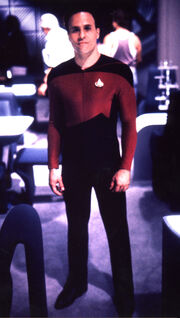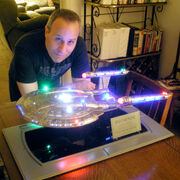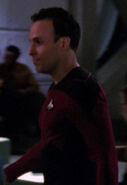m (→The Drex Files: grm.) |
m (→Star Trek affiliation: grm.) |
||
| Line 37: | Line 37: | ||
He struck up a friendship with [[Michael Okuda]], whom he admired, and kept in touch with him and his Scenic Art department, waiting for an opportunity to move over. That opportunity came when ''[[Star Trek: Deep Space Nine]]'' went into production and Okuda hired him, eventually becoming the lead scenic artist on the series. A grateful Drexler recalled, "''Looking through the trade paper, ''Variety'', I saw that [[Paramount Television|Paramount]] had made up their minds and they were going to do ''Star Trek: Deep Space Nine''. I got on the phone right away to Mike Okuda, who really stuck out his neck for me, and that's how it happened!''" (''[[The Official Star Trek: Deep Space Nine Magazine]]'', issue 11, p. 54) |
He struck up a friendship with [[Michael Okuda]], whom he admired, and kept in touch with him and his Scenic Art department, waiting for an opportunity to move over. That opportunity came when ''[[Star Trek: Deep Space Nine]]'' went into production and Okuda hired him, eventually becoming the lead scenic artist on the series. A grateful Drexler recalled, "''Looking through the trade paper, ''Variety'', I saw that [[Paramount Television|Paramount]] had made up their minds and they were going to do ''Star Trek: Deep Space Nine''. I got on the phone right away to Mike Okuda, who really stuck out his neck for me, and that's how it happened!''" (''[[The Official Star Trek: Deep Space Nine Magazine]]'', issue 11, p. 54) |
||
| − | After the ''Deep Space Nine'' series wrapped, Drexler moved over as a visual effects artist to [[Foundation Imaging]], for whom he worked on ''[[Star Trek: Voyager]]'', the only time during his ''Star Trek'' years he was not employed by Paramount. He subsequently, back in the employ of Paramount, worked as Senior Illustrator on ''[[Star Trek: Enterprise]]'', where he designed the {{EnterpriseNX}}. |
+ | After the ''Deep Space Nine'' series wrapped, Drexler moved over as a [[:Category: Visual effects companies|visual effects]] (VFX) artist to [[Foundation Imaging]], for whom he worked on ''[[Star Trek: Voyager]]'', the only time during his ''Star Trek'' years he was not directly employed by Paramount. He subsequently, back in the employ of Paramount, worked as Senior Illustrator on ''[[Star Trek: Enterprise]]'', where he designed the {{EnterpriseNX}}. |
[[File:Doug Drexler and Enterprise NX.jpg|thumb|Doug Drexler with the ''Enterprise'' (NX-01)]] |
[[File:Doug Drexler and Enterprise NX.jpg|thumb|Doug Drexler with the ''Enterprise'' (NX-01)]] |
||
He was the co-author and illustrator of the ''[[Star Trek: Deep Space Nine Technical Manual]]'', illustrator of the ''[[Star Trek Encyclopedia]]'', and is a contributor and editor of the popular ''[[Star Trek: Ships of the Line|Ships of the Line]]'' calendars. |
He was the co-author and illustrator of the ''[[Star Trek: Deep Space Nine Technical Manual]]'', illustrator of the ''[[Star Trek Encyclopedia]]'', and is a contributor and editor of the popular ''[[Star Trek: Ships of the Line|Ships of the Line]]'' calendars. |
||
Revision as of 09:31, 23 April 2013
Template:Realworld
- "To truly understand Doug Drexler, you have to go beyond the obvious. Sure he’s a talented illustrator and graphic designer. But the key to Doug is his eyes. Look at them closely and you’ll discover a Merlin the Magician looniness lurking beneath the surface. I’m convinced Doug knows secrets of the universe that the rest of us can’t even imagine. He’s also a big Sinatra fan, so you know the guy has taste."–Ira Steven Behr (DrexFiles(X))
Artist Douglas "Doug" Drexler (born 28 March 1953; age 71) has been creating or contributing to numerous Star Trek productions and publications since the 1970s. Starting out in fandom, Drexler has proven to be one of the most versatile production staffers in the Star Trek franchise.
Beginnings as fan
Born in New York City, Drexler was a first-generation Star Trek fan - although he was prohibited from watching television on school nights, Drexler managed to watch "This Side of Paradise", and subsequently to persuade his parents to allow him an hour's viewing a week, for Star Trek.
Drexler, along with Ron Barlow, ran a small Star Trek store in Manhattan, New York - "The Federation Trading Post" - during the mid-1970s. [1] Although failing initially, the store became more well-known after advertising during Original Series syndication, eventually becoming a focus for media contact about Star Trek. Drexler and Barlow were approached by Paradise Press to edit one of the first Star Trek magazines, the Star Trek Giant Poster Book. [2] It was through the store that Drexler met frequent collaborator Geoffrey Mandel, with whom he compiled one of the first technical reference works in Trek history: the USS Enterprise Officer's Manual, as well as Anthony Fredrickson, with whom he would author the Star Fleet Medical Reference Manual.
Drexler also contributed as co-writer of two Gold Key TOS comics issues, "This Tree Bears Bitter Fruit" (#47) and "Sweet Smell of Evil" (#48). On issue #47, he is credited as a Story Consultant.
Professional career

Winning an Academy Award for Dick Tracy (left) and an Emmy Award for Battlestar Galactica (right)
Drexler began working as a makeup artist in 1983 on the movie The Hunger, having been invited to do so by renowned makeup artist, Dick Smith. His other early work included Manhunter and Fatal Attraction.
After engaging in a long correspondence with Robert Justman and Michael Westmore during preproduction of Star Trek: The Next Generation, only to be unable to get a position on the series due to union rules, Drexler moved to Hollywood in 1990 to work on Dick Tracy (being made a member of the LA Union by Warren Beatty), for which he later won an Academy Award. Dick Tracy featured many Star Trek alumni in the cast: Colm Meaney, John Schuck, Ian Wolfe, Seymour Cassel, Hamilton Camp, Chuck Hicks, Mike Hagerty, Robert Costanzo, Ed McCready, Bert Remsen, Walker Edmiston and Michael J. Pollard.
Star Trek affiliation

In uniform on the set of "Transfigurations" in 1990

Doug Drexler on the set of Star Trek: Enterprise
Now able to work in California, Drexler approached Westmore to reapply for a position in the Next Generation make-up department. Westmore, incredulous at first that an Academy Award winner would want to work as a lesser paid makeup artist for a television show (though Westmore himself was one), hired him and Drexler's first assignment was putting on the Shakespeare makeup on Patrick Stewart for TNG: "The Defector". (The Official Star Trek: Deep Space Nine Magazine, issue 11, p. 53) Drexler worked as a make-up artist for three years, earning him two Emmy nominations.
Happy as Drexler was, working on Star Trek, he has professed that, "(...)the art department was calling to me and that's really where I wanted to be." He struck up a friendship with Michael Okuda, whom he admired, and kept in touch with him and his Scenic Art department, waiting for an opportunity to move over. That opportunity came when Star Trek: Deep Space Nine went into production and Okuda hired him, eventually becoming the lead scenic artist on the series. A grateful Drexler recalled, "Looking through the trade paper, Variety, I saw that Paramount had made up their minds and they were going to do Star Trek: Deep Space Nine. I got on the phone right away to Mike Okuda, who really stuck out his neck for me, and that's how it happened!" (The Official Star Trek: Deep Space Nine Magazine, issue 11, p. 54)
After the Deep Space Nine series wrapped, Drexler moved over as a visual effects (VFX) artist to Foundation Imaging, for whom he worked on Star Trek: Voyager, the only time during his Star Trek years he was not directly employed by Paramount. He subsequently, back in the employ of Paramount, worked as Senior Illustrator on Star Trek: Enterprise, where he designed the Enterprise NX-01.

Doug Drexler with the Enterprise (NX-01)
He was the co-author and illustrator of the Star Trek: Deep Space Nine Technical Manual, illustrator of the Star Trek Encyclopedia, and is a contributor and editor of the popular Ships of the Line calendars.
During his tenure as scenic artist on Deep Space Nine, Drexler taught himself the Adobe Illustrator software which served him well in providing the technical illustrations for the Manual and Encyclopedia. He went on to master the CGI LightWave 3D software as well, the build of the Breen warship for DS9: "Penumbra" being his first contribution in this format for the franchise. (Star Trek: The Magazine Volume 1, Issue 7, p. 50) His mastery of the software, aside for his regular work for televised Star Trek, also served him well, when he was asked by Pocket Books to provide (CGI) covers for several of their novels, most notably the covers of the Star Trek: Vanguard series. (Star Trek Magazine issue 162, pp. 82-84)
Post-Star Trek career
Drexler recently worked as Visual Effects CG Supervisor on Ronald D. Moore's Battlestar Galactica franchise (two VFX Emmy wins), its short lived prequel series, Caprica, and the more recent Battlestar Galactica: Blood & Chrome (2012) direct-to-DVD movie. Drexler acted as a technical consultant for the Remastered Original Series. Credited under the pseudonym "Max Rem" (occasionally also used in the Ships of the Line-calendars), as well as under his own name, Drexler also worked on the fan made internet series Star Trek: New Voyages (2004-2007). He worked as visual effects artist, executive producer, make-up artist, casting director, and editor on the series and wrote the story for the episode "In Harms Way".
Drexler is married to Enterprise food stylist Dorothy Duder.
The Drex Files
Happy as Drexler was, being employed in all the franchises he wanted to be involved with, he, as the die-hard Star Trek fan he had always been, did want to disseminate all the knowledge he had accumulated over the the years to fellow Star Trek fans. To this end he started his internet blog, the DrexFiles(X) on 14 December 2008. For four years running, an enormous amount of behind-the-scenes information was posted on this blog, virtually all contents not being available anywhere in print. Over the four following years, Drexler's blog has amassed a vast and dedicated following, not few of them active participatants (Memory Alpha admin Jörg Hillebrand having been among the most active ones). Not only fans were enticed to participate in his blog, former VFX production staff colleagues, such as Brandon MacDougall, Robert Bonchune, Adam Buckner, Dana White Shea, and many more, also contributed to his blog. The most prolific former production staff contributors to Drexlers' blog, however, were beyond any doubt, Rick Sternbach, Michael Okuda and Andrew Probert, providing a considerable amount of additional information that was neither fit for "official" publications nor having been published in print. Haphazardly as the blog might have been organized, it did provide a behind-the-scenes look into to production of virtually all Star Trek productions set in the prime universe and was as such an indispensable source of information on what Star Trek was all about. The "DrexFiles" haves proven to be an inspiration for the companion site of John Eaves, who started his likewise successful blog, Eavesdropping with Johnny, on 16 March 2009. He stated on that occasion, " I have to thank the ever and all talented master of media and VFX illusionist, Doug Drexler, for encouraging me to get off my fat butt and finally start a fun blog page!!! I have always wanted to have place to share the fun and adventures of those glorious movie and Star Trek days with friends, coworkers and fans of the films and shows..." [3]
Though activity on the blog had considerably slackened off from 2011 onward, its importance as an archive, due to its size by then, had not lessened.
Much to the dismay of virtually everybody, the blog was taken down in the early days of March 2013, due to perceived copyright infringements, having been put forward by, of all people, former VFX colleagues. Drexler has reiterated on his FaceBook page, "You know how I brand all the images I post with Drex Files. Several of my VFX colleagues took exception to that. They felt I was claiming credit for it all by doing that. I received a couple of angry notes that were upsetting. I felt the best thing was to off-line it for now. My intention was never to steal credit, in fact I felt like I was promoting everyone’s work. Drex Files regulars know that I note credits for work whenever I have the info, and if I don’t, I appeal to the audience to speak up if they know something about it. So for now, the Drex Files is dark, at least until I have a chance to think about it and review it." [4] This has never been an idle boast. Drexler, whenever he could, gave credit where credit was due, not seldomly appealing to his following to identify credit when he was not able to at the time, such as in the case of the CGI Galor-class model, eventually identified through a concerted community effort as being a Brandon MacDougall build. [5](X)
Appearances
Drexler has made two cameo appearances as a Starfleet officer. Upon starting work on Star Trek, he asked if he could appear as a background artist, in uniform, at some point. His wish was granted in the third season episode "Transfigurations", where he appeared as a command division Enterprise-D officer in several scenes set in Ten Forward. He also appeared in "These Are the Voyages..." as an Earth Starfleet ceremony attendee.
Perhaps not coincidentally, his name has been used referring to two Starfleet personnel, D. Drexler and Doug Drexler, on dedication plaques in the same time periods.
In addition, Drexler had a Klingon character named after him - Drex, the son of Martok and Sirella, who appeared in "The Way of the Warrior".
Star Trek credits
(This list is currently incomplete.)
- TNG:
- "The Defector" - Makeup Artist (uncredited, Season 3)
- "A Matter of Perspective" - Makeup Artist (uncredited)
- "Allegiance" - Special Effects Makeup Artist (uncredited)
- "Unification II" - Makeup Artist (uncredited, Season 5)
- "Violations" - Makeup Artist (uncredited)
- "Conundrum" - Makeup Artist (uncredited)
- "Power Play" - Makeup Artist (uncredited)
- "The Inner Light" - Special Effects Makeup Artist (uncredited)
- "Time's Arrow" - Makeup Artist (uncredited)
Emmy Award nominations
- 1990 Emmy Award nomination as for the episode "Allegiance" in the category Outstanding Achievement in Makeup for a Series, shared with Michael Westmore, Gerald Quist, June Westmore, Hank Edds, John Caglione, Jr., and Ron Walters
- 1993 Emmy Award nomination as for the episode "The Inner Light" in the category Outstanding Achievement in Makeup for a Series, shared with Michael Westmore, Gerald Quist, June Abston Haymore, Karen Westerfield, and Jill Rockow
Bibliography
- Star Trek Giant Poster Book magazine series, 1976 – Author/Editor
- This Tree Bears Bitter Fruit, 1977 – Story Consultant
- Sweet Smell of Evil, 1977 – Co-author
- Star Fleet Medical Reference Manual, 1977 – Co-illustrator
- USS Enterprise Officer's Manual, 1980 – Illustrator
- Star Trek Encyclopedia, 2nd ed., 1997 & 3rd ed, 1999 – Illustrator
- Star Trek: Deep Space Nine Technical Manual, 1998 – Co-author/Illustrator
- Star Trek Sticker Book, 1999 – Illustrator
- Star Trek: Ships of the Line calendar series, from the 2004 issue onward – Co-Illustrator/Editor
- Star Trek: Vanguard novel series, 2005 – Cover Illustrator
- Ships of the Line (book), 2006 – Co-Illustrator/Co-Editor
Star Trek interviews
- "Doug Drexler: Scenic Artist", The Official Star Trek: Deep Space Nine Magazine, issue 11, March 1995, pp. 50-56, interviewed by David Hirsch
- DS9 Season 5 DVD special feature "A new Enterprise", interviewed on 7 November 2002
- ENT Season 4 DVD special feature "Inside the "Mirror" Episodes"
- "Doug Drexler: The Evolution of an Artist", The official STAR TREK prop and costume auction catalog, 2010, pp. 18-23, interviewed by Alec Peters
- TNG Season 1 Blu-ray special feature, "Stardate Revisited, Part 3: The Continuing Mission" (2012)
Further reading
- "Doug Drexler", Star Trek: The Magazine Volume 1, Issue 21, January 2001, pp. 68-73
- "Doug Drexler (Part 2)", Star Trek: The Magazine Volume 1, Issue 22, February 2001, pp. 82-89
- "Behind the Scenes: Designing the Ti'Mur", Star Trek: The Magazine Volume 3, Issue 3, July 2002, pp. 20-24
External links
- DrexFiles(X) - Doug Drexler's blog
- Template:IMDb-link
- Doug Drexler at Battlestar Wiki
- Doug Drexler at Wikipedia
- 2002 Interview with Doug Drexler at Trekweb.com
- 2006 Interview with Doug Drexler at TrekPlace.com

